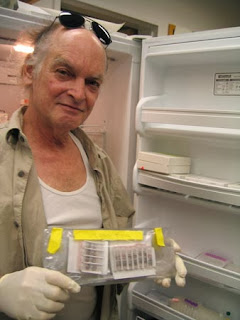 |
Nanotechnology
http://nanogloss.com/wp-content/uploads/2009/06/nanotechnology.jpg |
When they say "the world is a small place" I think, "the world is becoming a smaller place." As trends would show, technology has kept getting smaller and smaller. 25 years ago a cell phone was the size of small computer speaker, and now we have phones that fit in the palm of our hands. The people I learned about this week changed the world and helped us make a smooth transition into the digital age.
 |
At a Microscopic Level
http://static.ddmcdn.com/gif/gold-nanotech-2.jpg |
How did they change the world? How could it be done? These guys were working on a molecular level, a level we couldn't even see with a microscope at the time. As Feynman realized technology at the nanolevel changes the laws of physics. Surface tension beats gravity, and the very nature of the nanoscale objects can be used to create new effects. Not only were they working in a realm they couldn't see, but it was a realm with entirely new laws.
 |
Earliest Atom Imagery
http://blogs.knoxnews.com/munger/atomsphotos.jpg |
The projects I learned about this week seemed like they came from a Sci-Fi movie. There was a Ford assembly plant at a molecular level, a form of carbon unknown to man, atom imagery and manipulation, and more. They even discovered nanoparticles in sewage sludge. Just to reiterate my point. They couldn't see the particles, they didn't know the laws, and they embarked on impossible-sounding projects. I'm not sure if the people we learned about this week were artists or wizards, but their immense creativity and scientific knowledge shaped the portable world of today.
 |
Nanoparticles in Sewer Sludge
http://www.ethlife.ethz.ch/archive_articles/080715-nano_in_klaeranlage/klaerschlamm-l.jpg?hires |
Sources:
1.
Nanotechnology. Digital image. Nano Glass. N.p., n.d. Web. 24 Nov. 2013. <http://nanogloss.com/wp-content/uploads/2009/06/nanotechnology.jpg>.
2.
Gold Nano-Tech. Digital image. DDMCDN. N.p., n.d. Web. 24 Nov. 2013. <http://static.ddmcdn.com/gif/gold-nanotech-2.jpg>.
3.
Atoms Photos. Digital image. Knox News. N.p., n.d. Web. 24 Nov. 2013. <http://blogs.knoxnews.com/munger/atomsphotos.jpg>.
4.
Nano In Klaeranlage. Digital image. Eth Life. N.p., n.d. Web. 24 Nov. 2013. <http://www.ethlife.ethz.ch/archive_articles/080715-nano_in_klaeranlage/klaerschlamm-l.jpg?hires>.
5.
Bonsor, Kevin. "How Nanotechnology Works." HowStuffWorks. N.p., n.d. Web. 24 Nov. 2013. <http://www.howstuffworks.com/nanotechnology.htm>.











